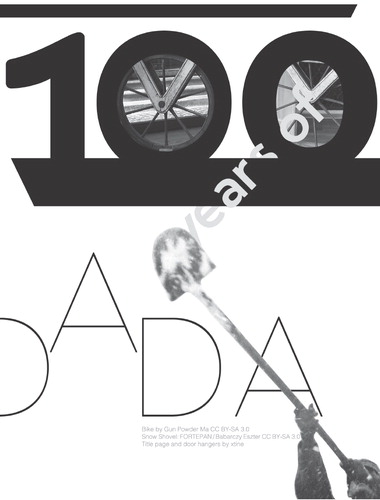Through absurd repetitions of collage, sound, performance, readymades, and poetry, the DADAists made art that intersected with politics to push against the boundaries and expectations of artists, viewers, and the spaces where art and life was performed. The line between the two—art and life, or performance and living—were purposely blurred. The long-term effect was a cultural broadening of that line between art and life—performance and living.
In this celebration of the 100th anniversary of the DADA movement for the community of readers and participants of the Visual Communication Quarterly, I hope (with all of my optimism and enthusiasm) you will enjoy three works of art and life by communication and media scholars included in this sub-issue that perform this relevant border crossing ritual—between art and life—that the old DADAists staged nightly.
From 2007 until 2012 I regularly attended the VisCom Conference. If you're unfamiliar, it is a low key annual conference for visual communication scholars, usually in the western part of the United States. Aside from being a lot of fun, it is a place to test new modes of presentation, try ideas and be open to failure, to gain honest feedback, and to find dear friends in the viscom community. For six years, I saw Marjorie Yambor perform renditions of poetic communication effects scholarship unlike anything in the field. When I put out the call for this issue, she was one of the first scholars who came to my mind as someone who I hoped would put fingers to keyboard. I'm delighted to include Yambor's, “The Spirit of '16: A Dada Manifesto in Support of Subversive Supremacy” in this sub-issue, complete with cat pictures.
While I adore Yambor's Spirit as a personal manifesto, I find balance in coupling it with a visual account of contemporary politics. Stephanie A. Martin's “Dada in the Public Square: Police, Protest, and Creative Dissent” shows how “much like the original Dada movement came about in response to disillusionment over the brutality of World War I and the spirit of unquestioned nationalism many believed allowed that conflict to rage, so today's protestors are striking back against state practices that seek to silence them” (p. 86). This rhetorical article is also, in a way, documentary. Martin writes about the convention she attended—photographing while formulating the thoughts that went into this article.
The third piece comes from McKenzie Wark who initially wrote “RetroDada Manifesto” at the invitation of Anita Hugi and David Dufresne for a March 2016 event to celebrate the Dada centenary at Cabaret Voltaire in Zürich where DADA began. This work weaves Yambor and Martin with the personal and political, the interior and exterior, and the past and future, to reveal that we are in it, we were in it, we will always be in it. Wark writes, “There is no escape from the history yet to be unmade!”Citation1
It is important to note that this tribute is published as an open source text. I designed it to be distributed on door hangers to suggest that a “RetroDada Manifesto” might be your next business calling card or a message to Housekeeping: please do disturb and disrupt! You, or perhaps your students, are also invited to reimagine other ways to reprint it. Feel free to share, remix, and to clean house.
It has now been more than one hundred years since Hugo Ball first uttered at Cabaret Voltaire: “How does one achieve eternal bliss? By saying dada.”Citation2
References
- McKenzie Wark's “Retro Dada Manifesto” is available in English, French, German, and Italian to remix, reprint, and redistribute: http://www.publicseminar.org/2016/02/retrodada-manifesto/
- See Hugo Ball's “Dada Manifesto” in Bruce Sterling's 100 year recap for Wired Magazine, “Hugo Ball's Dada Manifesto, July 1916” uploaded on 11 July 2016, https://www.wired.com/beyond-the-beyond/2016/07/hugo-balls-dada-manifesto-july-2016/ or you can also find it uploaded by Joshua Callahan on Scribd, https://www.scribd.com/doc/202859327/1916-Hugo-Ball-Dada-Manifesto

